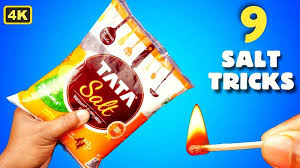In the world of life hacks and clever shortcuts, the “SALT TRICK” is one that has been passed down through generations. While its origins remain unclear, this versatile and effective technique has remained popular due to its simplicity and the wide range of problems it can solve. Whether you’re dealing with spills, odors, or even cleaning chores, the Salt Trick is one of those kitchen staples that can serve as a quick fix for a variety of situations.
What Is the Salt Trick?
The Salt Trick refers to using salt—yes, the common table salt found in every kitchen—as a natural and inexpensive solution for a range of household tasks. From cleaning to cooking and beyond, salt’s crystalline structure and absorbent nature make it a surprisingly useful tool in various scenarios. Unlike commercial cleaners or expensive solutions, salt is readily available, non-toxic, and environmentally friendly, making it a go-to for those looking to simplify their routines or find a quick solution without the need for fancy equipment.
Common Uses of the Salt Trick
- Removing Stains from Carpets and Fabric: One of the most well-known uses for salt is as a stain remover. If you’ve spilled red wine, coffee, or juice on a carpet or fabric, salt can help absorb the liquid before it has a chance to set. Simply sprinkle salt generously over the stain, let it sit for a few minutes to absorb the liquid, and then vacuum it up. For stubborn stains, mix salt with a bit of water to form a paste, apply it to the stain, and gently scrub it away.
- Cleaning Cast-Iron Cookware: Cast-iron skillets are a beloved kitchen item, but they require special care to maintain their seasoning and prevent rust. One simple trick to clean cast-iron cookware without damaging the surface is using salt. After cooking, pour some coarse salt into the pan while it’s still warm and scrub it with a paper towel. The salt acts as a gentle abrasive, loosening food residue while preserving the seasoning layer. Rinse and dry the skillet thoroughly afterward.
- Absorbing Odors: Salt is a natural deodorizer. If you have a stinky fridge, shoes, or even garbage cans, placing a bowl of salt inside can help absorb the unpleasant odors. This is particularly helpful in musty or damp areas. You can also make a homemade air freshener by mixing salt with essential oils for a fresh, clean scent that lingers for hours.
- Dealing with Burnt Food on Pots and Pans: If you’ve ever burned food in a pot, you know how difficult it can be to remove the burnt residue. A quick fix is to sprinkle some salt into the pot, add a bit of water, and let it simmer for a few minutes. The salt will help loosen the burnt food, making it easier to scrub away without damaging the pot’s surface.
- Reviving Wilted Vegetables: Over time, fresh vegetables can wilt and lose their crispness, especially if left in the fridge for too long. Revive them by soaking them in cold water with a pinch of salt. The salt helps the plant cells reabsorb water, making your vegetables crisp and fresh again. This trick works particularly well for leafy greens like lettuce, spinach, or herbs.
- Preventing Ice from Sticking: In the winter months, salt is often used on driveways and sidewalks to prevent ice from forming and making surfaces slippery. However, you can use the same principle on a smaller scale at home. If you find that ice cubes are sticking together in your freezer or melting too quickly in your drink, a small pinch of salt in your ice tray can prevent this problem by lowering the freezing point and ensuring clear, well-separated ice.
- Enhancing Flavor: While this might seem like a no-brainer, it’s worth mentioning that salt can be used as a flavor enhancer in cooking beyond its traditional role in seasoning food. A pinch of salt added to desserts like chocolate cake or caramel can bring out the natural sweetness, while also adding depth to the overall flavor profile.
- Dealing with Splattered Oil: Cooking with hot oil can sometimes result in greasy splatters all over the kitchen. A simple way to clean up these messes is by sprinkling some salt over the fresh oil splatters. The salt absorbs the oil, making it easier to wipe away with a paper towel.
The Science Behind the Salt Trick
So, why does salt work so well in these scenarios? Salt has an interesting set of physical properties that make it a useful tool in many situations. First and foremost, salt is hygroscopic, meaning it attracts and absorbs moisture. This makes it excellent for stain removal, odor absorption, and even preventing excess moisture from damaging surfaces.
Salt also acts as a mild abrasive. This makes it effective at scrubbing away stuck-on food particles, without causing significant harm to most surfaces, such as cookware or fabric. Moreover, salt’s natural mineral content and low pH help it act as a mild disinfectant and preservative.
Eco-Friendly and Economical
Aside from its versatility and efficiency, the Salt Trick also stands out for being eco-friendly. In an age where more and more people are turning to sustainable practices, salt is a non-toxic, biodegradable option that is both effective and gentle on the environment. It doesn’t contain harsh chemicals like many store-bought products, which can be harmful to both human health and the ecosystem.
In terms of cost, salt is incredibly affordable. Unlike specialized cleaning products or store-bought solutions, a simple box of table salt can be used for numerous household tasks, making it one of the most budget-friendly tricks you can rely on.
Conclusion
The Salt Trick is one of those time-tested hacks that never seems to go out of style. It is easy to use, cheap, and effective, making it a go-to for many homeowners, especially when looking for fast solutions to everyday problems. Whether you’re trying to tackle a pesky stain, enhance your cooking, or simply keep your home smelling fresh, salt is a simple yet powerful tool that should have a place in every home. The next time you find yourself facing a common household challenge, consider giving the Salt Trick a try—it might just be the solution you need.


